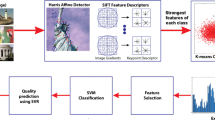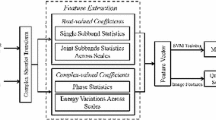Abstract
No reference image quality assessment (NR-IQA) is a challenging task since reference images are usually unavailable in real world scenarios. The performance of NR-IQA techniques is vastly dependent on the features utilized to predict the image quality. Many NR-IQA techniques have been proposed that extract features in different domains like spatial, discrete cosine transform and wavelet transform. These NR-IQA techniques have the possibility to contain redundant features, which result in degradation of quality score prediction. Recently impact of general purpose feature selection algorithms on NR-IQA techniques has shown promising results. But these feature selection algorithms have the tendency to select irrelevant features and discard relevant features. This paper presents fifteen new feature selection algorithms specifically designed for NR-IQA, which are based on Spearman rank ordered correlation constant (SROCC), linear correlation constant (LCC), Kendall correlation constant (KCC) and root mean squared error (RMSE). The proposed feature selection algorithms are applied on the extracted features of existing NR-IQA techniques. Support vector regression (SVR) is then applied to selected features to predict the image quality score. The fifteen newly proposed feature selection algorithms are evaluated using eight different NR-IQA techniques over three commonly used image quality assessment databases. Experimental results show that the proposed feature selection algorithms not only reduce the number of features but also improve the performance of NR-IQA techniques. Moreover, features selection algorithms based on SROCC and its combination with LCC, KCC and RMSE perform better in comparison to other proposed algorithms.




Similar content being viewed by others
Explore related subjects
Discover the latest articles, news and stories from top researchers in related subjects.References
Li Q, Lin W, Xu J, Fang Y (2016) Blind image quality assessment using statistical structural and luminance features. IEEE Trans Multimedia 18(12):2457–2469
Liu D, Li F, Song H (2016) Image quality assessment using regularity of color distribution. IEEE Access 4:4478– 4483
Bampis CG, Goodall TR, Bovik AC (2016) Sampled efficient full-reference image quality assessment models. In: 2016 50th Asilomar conference on signals, systems and computers. IEEE, Pacific Grove, California (CA), USA, pp 561–565
Oszust M (2016) Full-reference image quality assessment with linear combination of genetically selected quality measures. PloS one 11(6):e0158333
Saha A, Wu QJ (2016) Full-reference image quality assessment by combining global and local distortion measures. Signal Process 128:186–197
Wen Y, Li Y, Zhang X, Shi W, Wang L, Chen J (2017) A weighted full-reference image quality assessment based on visual saliency. J Vis Commun Image Represent 43:119–26
Deriche M (2014) An image quality index based on mutual information and neural networks. Arab J Sci Eng 39(3):1983–93
Lahoulou A, Bouridane A, Viennet E, Haddadi M (2013) Full-reference image quality metrics performance evaluation over image quality databases. Arab J Sci Eng 38(9):2327–2356
Lai MJ (2016) Reduced reference image quality assessment, Ph.D. thesis, UTAR
Golestaneh S, Karam LJ (2016) Reduced-reference quality assessment based on the entropy of dwt coefficients of locally weighted gradient magnitudes. IEEE Trans Image Process 25(11):5293–5303
Wu J, Lin W, Shi G, Li L, Fang Y (2016) Orientation selectivity based visual pattern for reduced-reference image quality assessment. Inf Sci 351:18–29
Balanov A, Schwartz A, Moshe Y (2016) Reduced-reference image quality assessment based on dct subband similarity. In: 2016 Eighth international conference on quality of multimedia experience (qoMEX). IEEE, Lisbon, Portugal, pp 1–6
Wang Z, Bovik AC, Sheikh HR, Simoncelli EP (2004) Image quality assessment: from error visibility to structural similarity. IEEE Trans Image Process 13(4):600–612
Wang Z, Simoncelli EP, Bovik AC (2003) Multiscale structural similarity for image quality assessment. In: Conference record of the Thirty-Seventh asilomar conference on signals, systems and computers, 2004, vol 2. IEEE, Pacific Grove, California (CA), USA, pp 1398–1402
Sheikh HR, Bovik AC (2006) Image information and visual quality. IEEE Trans Image Process 15(2):430–444
Sheikh HR, Bovik AC, De Veciana G (2005) An information fidelity criterion for image quality assessment using natural scene statistics. IEEE Trans Image Process 14(12):2117–2128
Liu L, Dong H, Huang H, Bovik AC (2014) No-reference image quality assessment in curvelet domain. Signal Process Image Commun 29(4):494–505
Liu L, Hua Y, Zhao Q, Huang H, Bovik AC (2016) Blind image quality assessment by relative gradient statistics and adaboosting neural network. Signal Process Image Commun 40:1–15
Wu Q, Li H, Meng F, Ngan KN, Luo B, Huang C, Zeng B (2016) Blind image quality assessment based on multichannel feature fusion and label transfer. IEEE Trans Circuits Syst Video Technol 26(3):425–440
Xu J, Ye P, Li Q, Du H, Liu Y, Doermann D (2016) Blind image quality assessment based on high order statistics aggregation. IEEE Trans Image Process 25(9):4444–4457
Lu P, Li Y, Jin L, Han S (2016) Blind image quality assessment based on wavelet power spectrum in perceptual domain. Transactions of Tianjin University 22(6):596–602
Lu W, Xu T, Ren Y, He L (2016) Statistical modeling in the shearlet domain for blind image quality assessment. Multimedia Tools and Applications 75(22):14417–14431
Moorthy AK, Bovik AC (2011) Blind image quality assessment: from natural scene statistics to perceptual quality. IEEE Trans Image Process 20(12):3350–3364
Saad MA, Bovik AC, Charrier C (2012) Blind image quality assessment: a natural scene statistics approach in the dct domain. IEEE Trans Image Process 21(8):3339–3352
Mittal A, Moorthy AK, Bovik AC (2012) No-reference image quality assessment in the spatial domain. IEEE Trans Image Process 21(12):4695–4708
Xue W, Mou X, Zhang L, Bovik AC, Feng X (2014) Blind image quality assessment using joint statistics of gradient magnitude and laplacian features. IEEE Trans Image Process 23(11):4850–4862
Liu L, Liu B, Huang H, Bovik AC (2014) No-reference image quality assessment based on spatial and spectral entropies. Signal Process Image Commun 29(8):856–863
Wang S, Deng C, Lin W, Huang G-B, Zhao B (2017) Nmf-based image quality assessment using extreme learning machine. IEEE Transactions on Cybernetics 47(1):232–243
Yan Y, Du S, Zhang H, Ma Y (2016) When spatial distribution unites with spatial contrast: an effective blind image quality assessment model. IET Image Process 10(12):1017–1028
Wang J, Li T, Shi Y-Q, Lian S, Ye J (2017) Forensics feature analysis in quaternion wavelet domain for distinguishing photographic images and computer graphics. Multimedia tools and Applications 76(22):23721–23737
Zhang Y, Sun X, Wang B (2016) Efficient algorithm for k-barrier coverage based on integer linear programming. China Communications 13(7):16–23
Yuan C, Sun X, Lv R (2016) Fingerprint liveness detection based on multi-scale lpq and pca. China Communications 13(7):60–65
Nizami IF, Majid M, Afzal H, Khurshid K (2017) Impact of feature selection algorithms on blind image quality assessment. Arab J Sci Eng :1–14
Zhang L, Zhang L, Bovik AC (2015) A feature-enriched completely blind image quality evaluator. IEEE Trans Image Process 24(8):2579–2591
Chang C-C, Lin C-J (2011) Libsvm: a library for support vector machines. ACM Trans Intell Syst Technol (TIST) 2(3):27
Smola AJ, Schölkopf B (2004) A tutorial on support vector regression. Stat Comput 14(3):199–222
Saad MA, Bovik AC, Charrier C (2010) A dct statistics-based blind image quality index. IEEE Signal Process Lett 17(6):583–586
Sheikh HR, Sabir MF, Bovik AC (2006) A statistical evaluation of recent full reference image quality assessment algorithms. IEEE Trans Image Process 15(11):3440–3451
Ponomarenko N, Lukin V, Zelensky A, Egiazarian K, Carli M, Battisti F (2009) Tid2008-a database for evaluation of full-reference visual quality assessment metrics. Adv Mod Radioelectron 10(4):30–45
Larson EC, Chandler DM (2010) Most apparent distortion: full-reference image quality assessment and the role of strategy. J Electron Imaging 19(1):011006–011006
Mittal A, Soundararajan R, Bovik AC (2013) Making a completely blind image quality analyzer. IEEE Signal Process Lett 20(3):209–212
Wei W, Fan X, Song H, Fan X, Yang J (2018) Imperfect information dynamic Stackelberg game based resource allocation using hidden Markov for cloud computing. IEEE Trans Serv Comput 11(1):78–89
Zhou Z, Yang C-N, Chen B, Sun X, Liu Q, QM J (2016) Effective and efficient image copy detection with resistance to arbitrary rotation. IEICE Trans Inf Syst 99(6):1531–1540
Author information
Authors and Affiliations
Corresponding author
Rights and permissions
About this article
Cite this article
Nizami, I.F., Majid, M. & Khurshid, K. New feature selection algorithms for no-reference image quality assessment. Appl Intell 48, 3482–3501 (2018). https://doi.org/10.1007/s10489-018-1151-0
Published:
Issue Date:
DOI: https://doi.org/10.1007/s10489-018-1151-0




